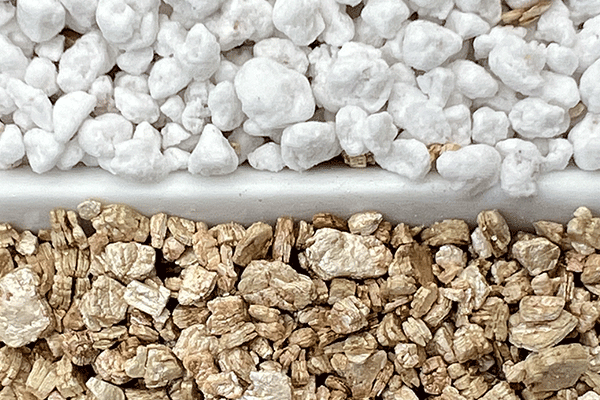Perlite vs. Vermiculite

Perlite vs. Vermiculite. What’s the Difference?
Perlite
Perlite is a naturally occurring mineral that is commonly used in horticulture as a soil amendment. Or it’s used alone as a medium for hydroponics or for starting cuttings. It is a lightweight, organic soil amendment that can be used to improve drainage and aeration in potting mixes. Perlite encourages strong root growth, prevents soil compaction, and helps drainage. Perlite is also used in the construction and manufacturing fields. where it is used in lightweight plasters, concrete and mortar, insulation, and ceiling tiles.
It may also be used to build composite materials that are sandwich-structured or to create syntactic foam. Perlite is currently used in commercial pool filtration technology as a replacement for diatomaceous earth filters. Perlite is an excellent filtration aid and is used extensively as an alternative to diatomaceous earth. Perlite is also used in cosmetics as an absorbent and mechanical exfoliant. Perlite can be replaced for all of its uses, and substitutes. Include diatomite, used for filter-aids, and expanded clay, an alternative lightweight filler.
Vermiculite
Vermiculite is a naturally occurring mineral that takes glossy flakes form, varying in color from dark gray to sandy brown. It’s a hydrous phyllosilicate mineral that undergoes significant expansion when heated, and exfoliation occurs when the mineral is heated sufficiently. Vermiculite is commonly used in horticulture as a means of improving soil quality. Or giving seedlings a helping hand to root more quickly.
It is lightweight, non-toxic, and sterile, and does not deteriorate over time. Vermiculite can absorb three or four times its weight in water. And it also attracts various plant nutrients such as potassium, magnesium, and calcium. These make it useful for propagation and for potting up plants that do best in moist compost, including house plants. Vermiculite is also used in the building industry, the car industry, and in packaging. Some common uses of vermiculite include.
– Improving soil quality and water retention in horticulture.
– Propagating cuttings and promoting root growth.
– Storing bulbs or root crops over winter.
– Adding to recently seeded lawns to keep grass seed from drying out while it germinates.
– Providing grit in worm bins to help worms digest food.
– Mixing with soil, peat, or compost to eliminate packed down soil in flower pots and houseplant containers. while allowing excellent aeration, reducing watering frequency and allowing root spread.
– Arranging flowers to eliminate the need to change the water, eliminate spills, and keep blooms fresh for days.
It is important to note that not all vermiculite products are safe, as some may contain asbestos. If you suspect that you have vermiculite insulation in your home, it is recommended to leave it alone and seek the help of a licensed asbestos contractor if you want it removed.
Perlite and Vermiculite Comparison
Perlite and vermiculite are both naturally occurring minerals that are commonly used in horticulture as soil amendments or alone as a medium for hydroponics or for starting cuttings. While they share some similarities, there are some key differences between Perlite vs. Vermiculite.
Perlite.
Increases drainage to the soil
Mixes with soil to improve aeration
Stores water on the surface of all its nooks and crannies
Provides root-zone oxygenation and drainage
Does not decompose in soil
Does not contain any essential plant nutrients
Ideal for seed starting or blending into potting mixes
Approved for organic gardening
pH level: 7.0 to 7.5
Vermiculite.
Mixes with soil and helps to retain water
Holds and releases a lot of water and nutrients
Acts more like a sponge in the way it soaks up water and holds on to it
More compressible and less porous than perlite
Provides good drainage
Retains moisture and nutrients
Contains a little potassium and magnesium
Ideal for potting up plants that need moist compost
Sold as medium or fine grade
Can be used in cuttings composts and seed sowing
Does not decompose in soil
Approved for organic gardening
pH level: 7.0 to 7.5
In summary, perlite is better for aerating soil and ensuring it drains properly, while vermiculite is better for water retention and holding onto nutrients. Both perlite and vermiculite can be good as a soil amendment, but they’re used for different purposes. It is important to choose the right one depending on the needs of your plants and the soil you are using. Also perlite and vermiculite can be used together in soil mixes. Mixing perlite and vermiculite can provide a balance of water retention and drainage, which can be beneficial for certain plants.
Perlite can be used to aerate the soil and improve drainage, while vermiculite can help retain moisture and nutrients. Mixing perlite and vermiculite in equal parts can create a well-draining soil mix that also retains moisture. However, it is important to note that the ratio of perlite to vermiculite will depend on the specific needs of the plants being grown and the type of soil being used. It is recommended to experiment with different ratios to find the best mix for your plants.
